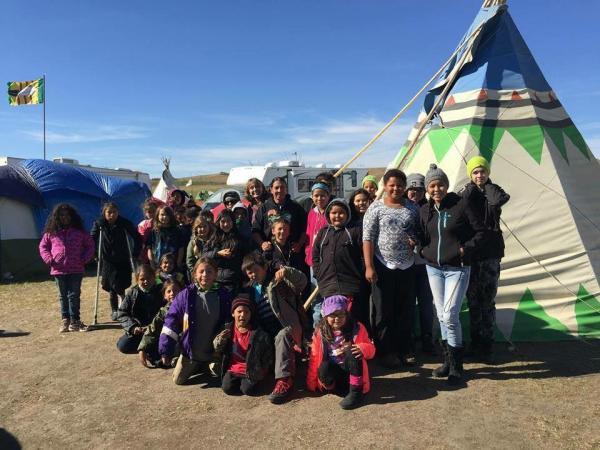And if we cannot protect the sacred, then what is going to be left for the next seven generations? We must ensure our children and show them that when we say we take care of the Earth and the environment, that we really will do that.”
—Pua Case, Mauna Kea protector
"Let us put our minds together and see what life we can make for our children.
—Sitting Bull

Standing Rock school. Image from Mní Wičhóni Nakíčižiŋ Owáyawa, Defenders of the Water School
On November 1, 2019, in North Dakota a rupture in the Keystone pipeline leaked 383,000 gallons of crude oil in a rural wetland. This spill comes exactly one year after the Standing Rock Sioux tribe renewed their lawsuit against the Dakota Access Pipeline (DAPL) in November 2018. The actions of water protectors to stop the DAPL has extensive reach, connecting in solidarity with other Indigenous communities that are peacefully protecting their land and sacred sites to ensure a future for us all.
Similarities from Standing Rock in 2016 continue today. These issues parallel environmental and Indigenous concerns throughout the region, nation and world––: from Louisiana’s Atchafalaya Basin, ––where the Bayou Bridge Pipeline (BBP) construction continued in spite of Indigenous water protectors and other residents pending legal challenges and threats to the United Houma Nation’s drinking water––to the coastal plain of the Arctic National Wildlife Refuge, ––where the Gwich’in Nation is fighting to protect their lands and caribou from pipelines and oil development. In summer 2019, the Standing Rock Sioux tribal members also gathered at the DAPL epicenter to show solidarity with Native Hawaiians, who are protecting Mauna Kea.
Background for CDE’s Toolkits
The toolkit was originally created in 2016 by Executive Committee Member and Associate Professor Phaedra Pezzullo. Since then, CDE Associate Director and Assistant Professor Tiara R. Na'puti has revisited the online toolkit annually to continue to help parents, educators and advocates talk with children about the Dakota Access Pipeline controversy and other issues that impact the ways of life of Indigenous and local people. In 2019, this effort is supported by an IMPART Award aimed at Teaching Indigenous Resilience Through Toolkits, to engage cCommunication sStudies curriculum with Native American and Indigenous Studies and deepen investigations about communication, culture, environment, climate change and resilience.
2019 Toolkit Projects
Students enrolled in Na'puti’s Rhetorical Criticism course within the Department of Communication at CU Boulder created toolkits on topics of their choosing. These toolkits communicate about expansive issues of Indigenous resilience.
View CDE and student-created toolkits
The materials include talking points, conversation guides, activities and resources that cover a range of issues such as climate change, sacred land, cultural appropriation and mascots (to name a few). These toolkits also provide resources for Indigenous and environmental groups working in solidarity with Standing Rock and other places like Mauna Kea and the Philippines where people continue to protect land, water and ensure a brighter future for coming generations.
The Center for Communication and Democratic Engagement hopes that more parents, educators, and students will expand these resources, which are meant as a springboard for education and activities with youth and other audiences to foster dialogue about issues at Standing Rock and places with ongoing environmental concerns. These materials also encourage dialogue about the meaning of Thanksgiving and the theme of Indigenous resilience.
…I would really like us all to do our part, beyond Native American Heritage Month.”
—Winona LaDuke
“We are all very much committed to standing in solidarity to protect what we have.
—Cherri Foytlin
We have a very close relationship to our relatives, because we are both standing for what is sacred: water. We are standing for the water from our mountain, and they, of course, are standing for their water.”
—Pua Case, on similarities from Mauna Kea and Standing Rock
“The coastal plain is sacred to the Gwich’in people and critical to our food security and way of life. It is no place for destructive seismic testing or oil rigs and pipelines.
—Bernadette Demientieff, executive director of the Gwich’in Steering Committee.
